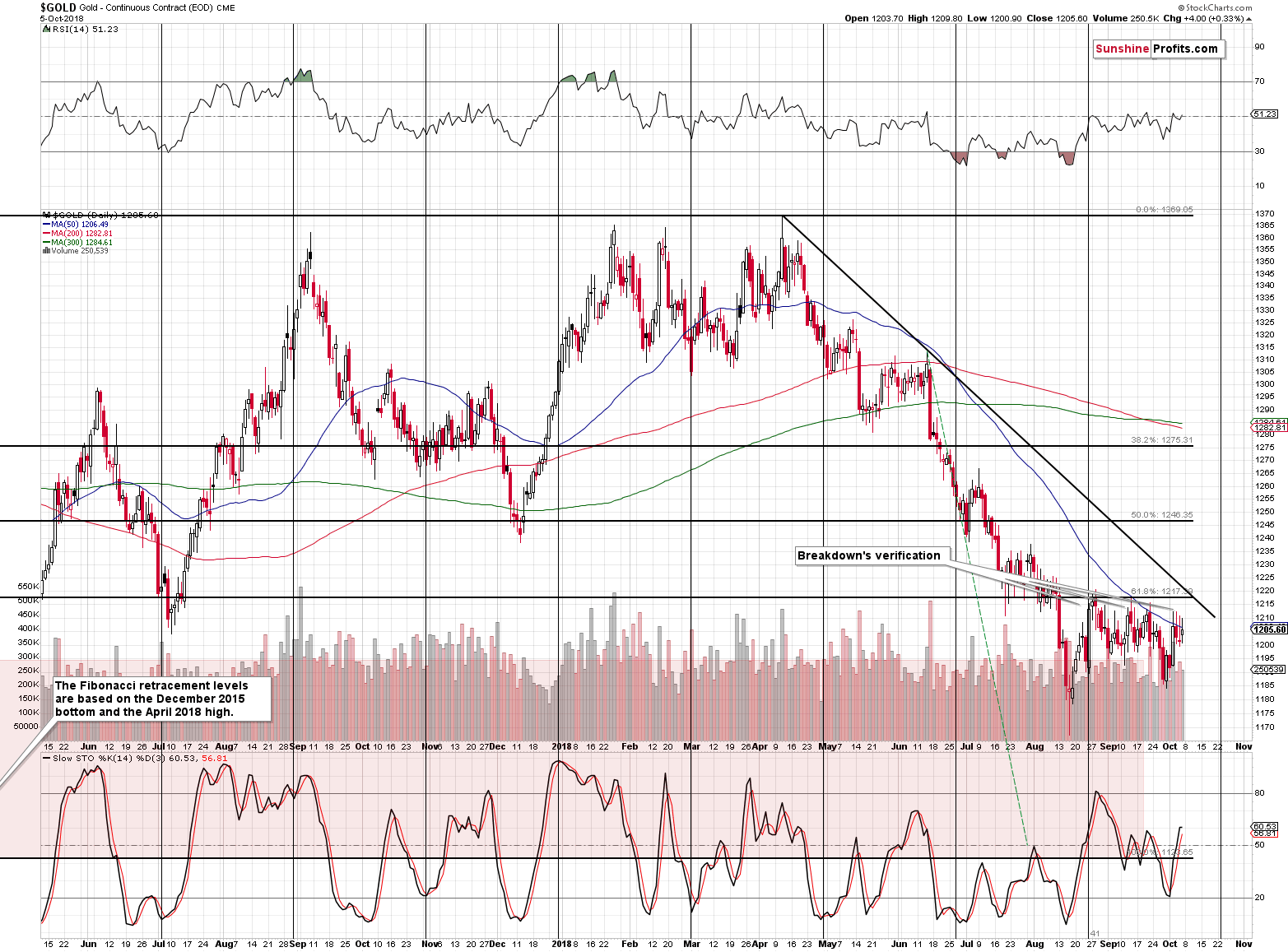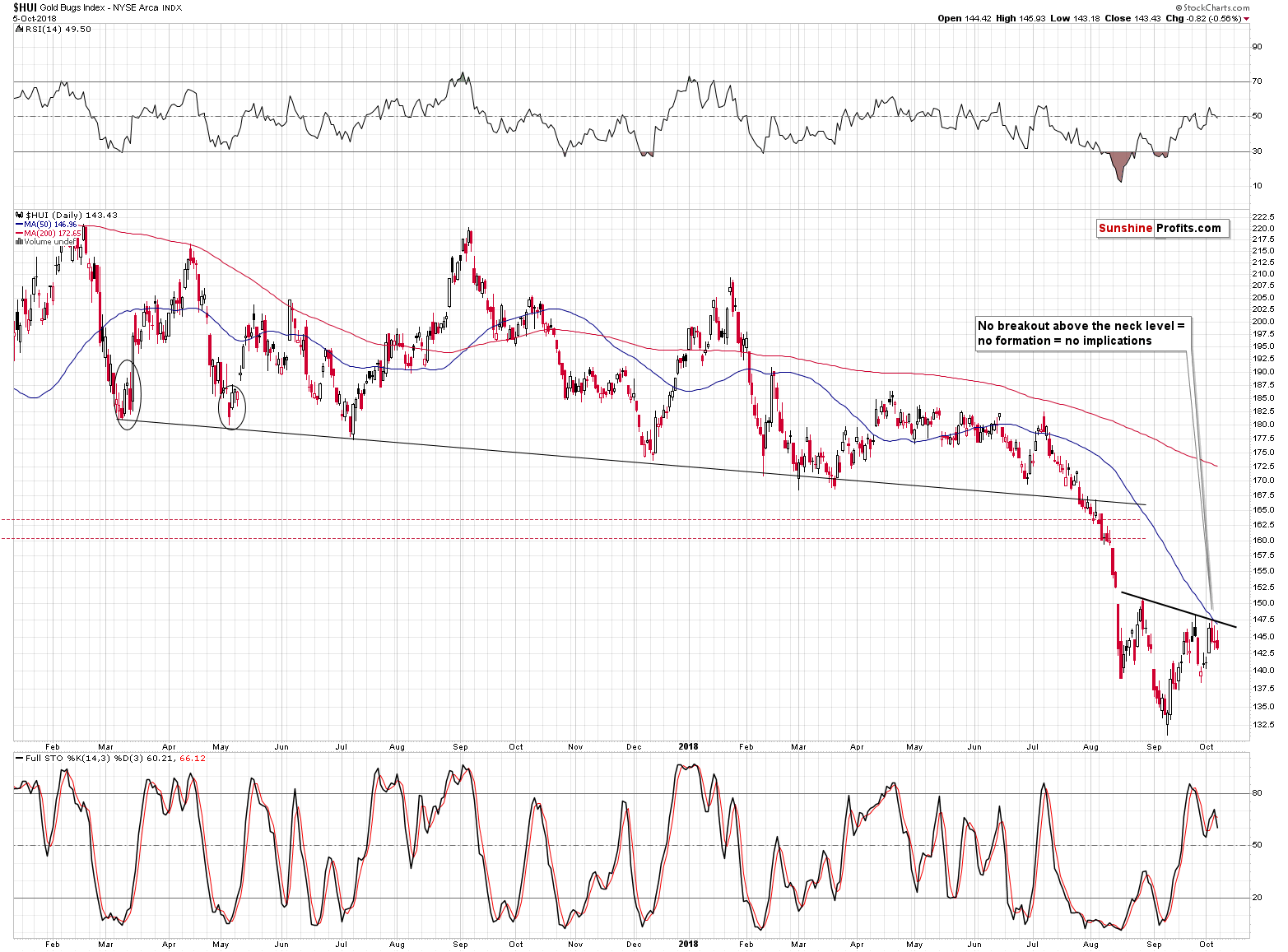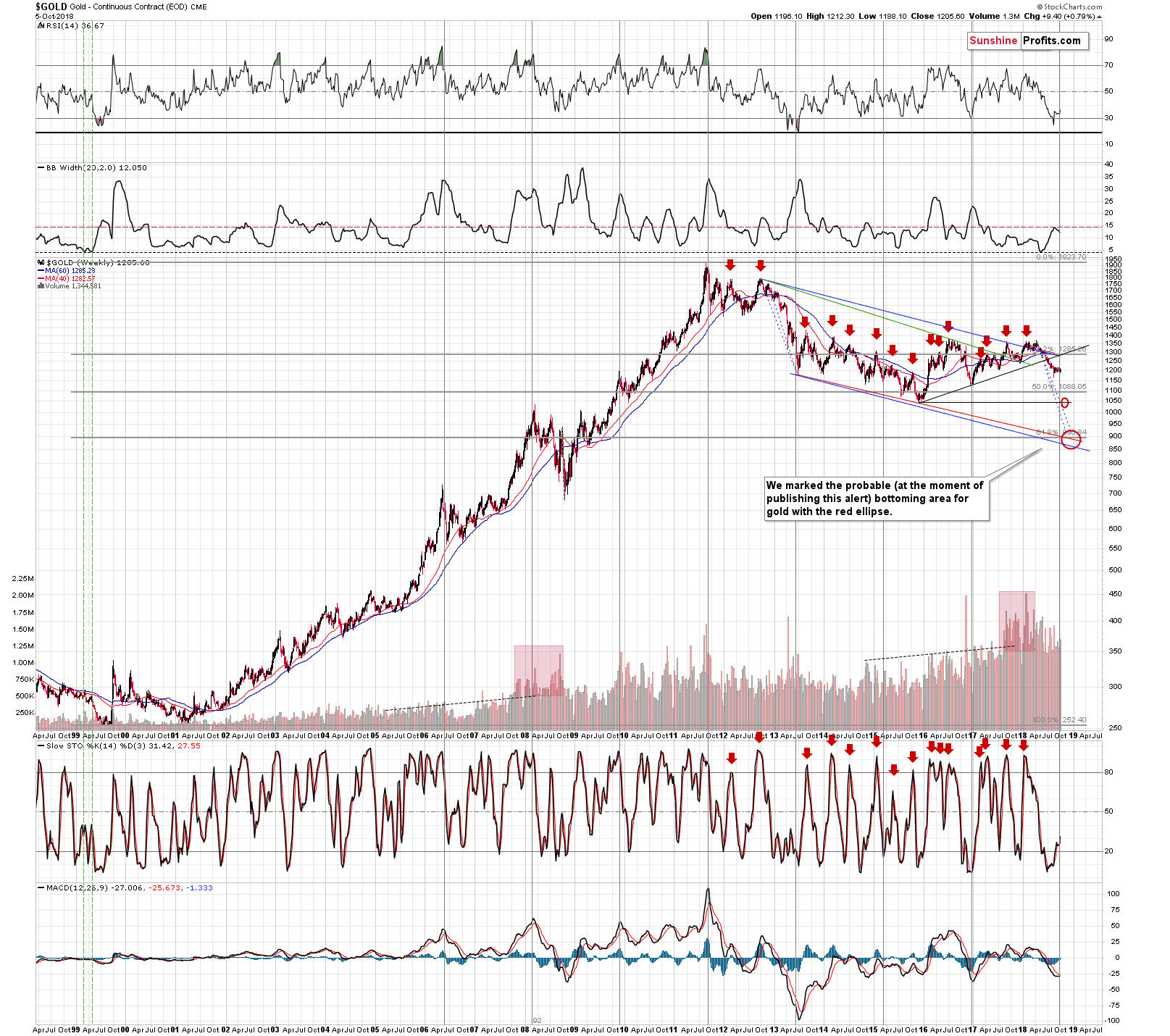Briefly: in our opinion, full (250% of the regular size of the position) speculative short positions in gold, silver and mining stocks are justified from the risk/reward perspective at the moment of publishing this alert.
The previous week is over and even though we haven’t seen any significant volatility in its final part, it doesn’t mean that we haven’t seen any meaningful signals. We did and one of them has important implications for the short term and a few others have much more important implications of the medium-term nature.
Let’s start with the short-term charts and short-term signals (charts courtesy of http://stockcharts.com).
Gold’s and Silver’s Tiny Rally
In Friday’s Alert, we wrote the following about gold’s inability to move above the previous highs:
There are attempts, but each of them fails a buyers are overwhelmed by the selling pressure. And the tiny details confirm the bearish outlook. In the past 3 days, the closing prices were lower each day and we can say the same thing about the levels that the price reached intraday.
There was yet another attempt of gold to move higher and while gold ended the session higher, the intraday low was once again lower than in the previous days. Overall the tendency for gold to move back and forth but lower overall remains in place.
We saw the same thing in silver.
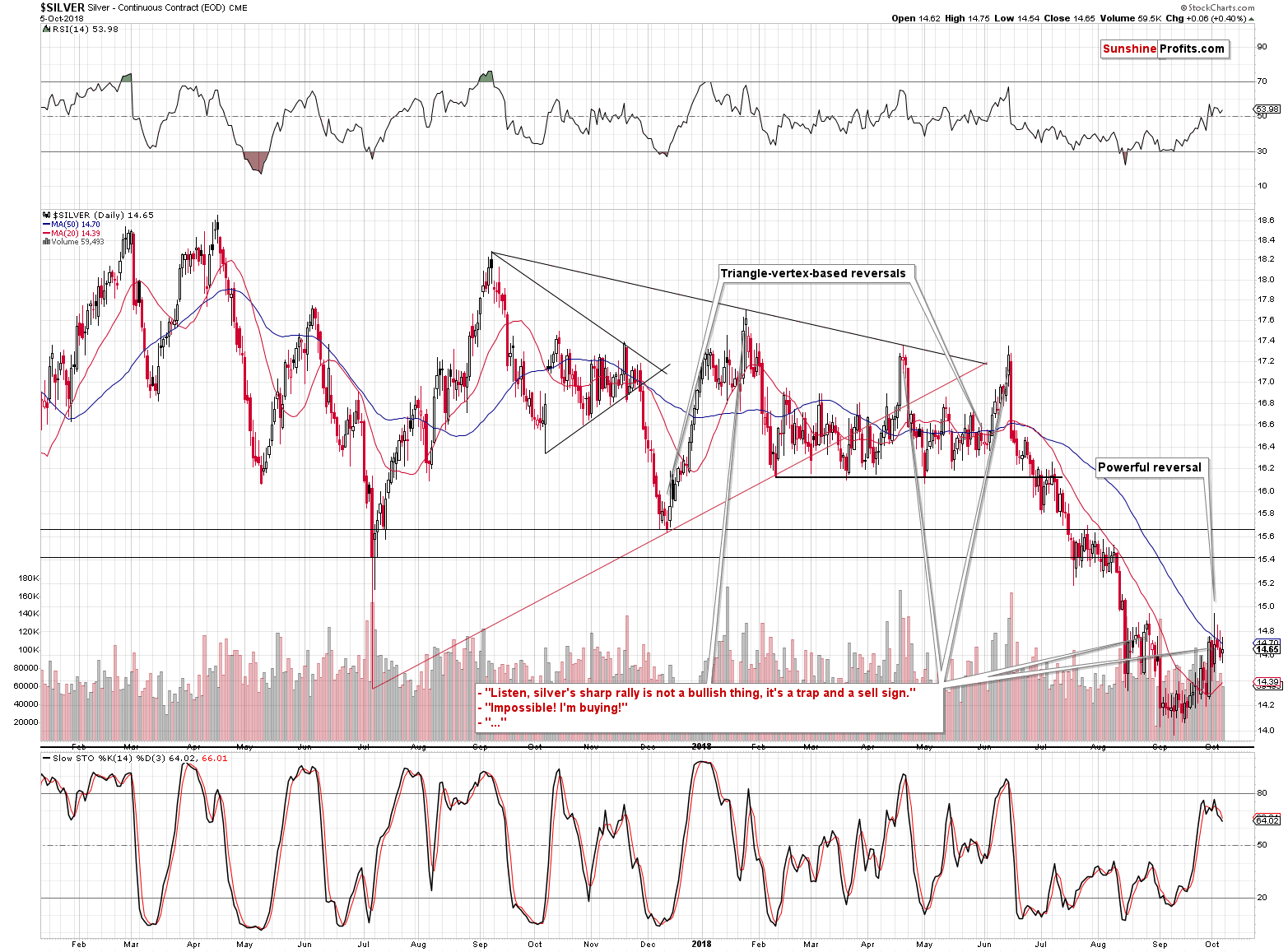
The intraday high was once again lower than on the preceding day. And once again, there was only an intraday attempt to move above the 50-day moving average that was invalidated before the session’s closing bell.
The above, plus silver’s recent short-term outperformance continue to support lower prices in the upcoming days and weeks. The outperformance can be seen even more clearly on the SLV ETF chart.
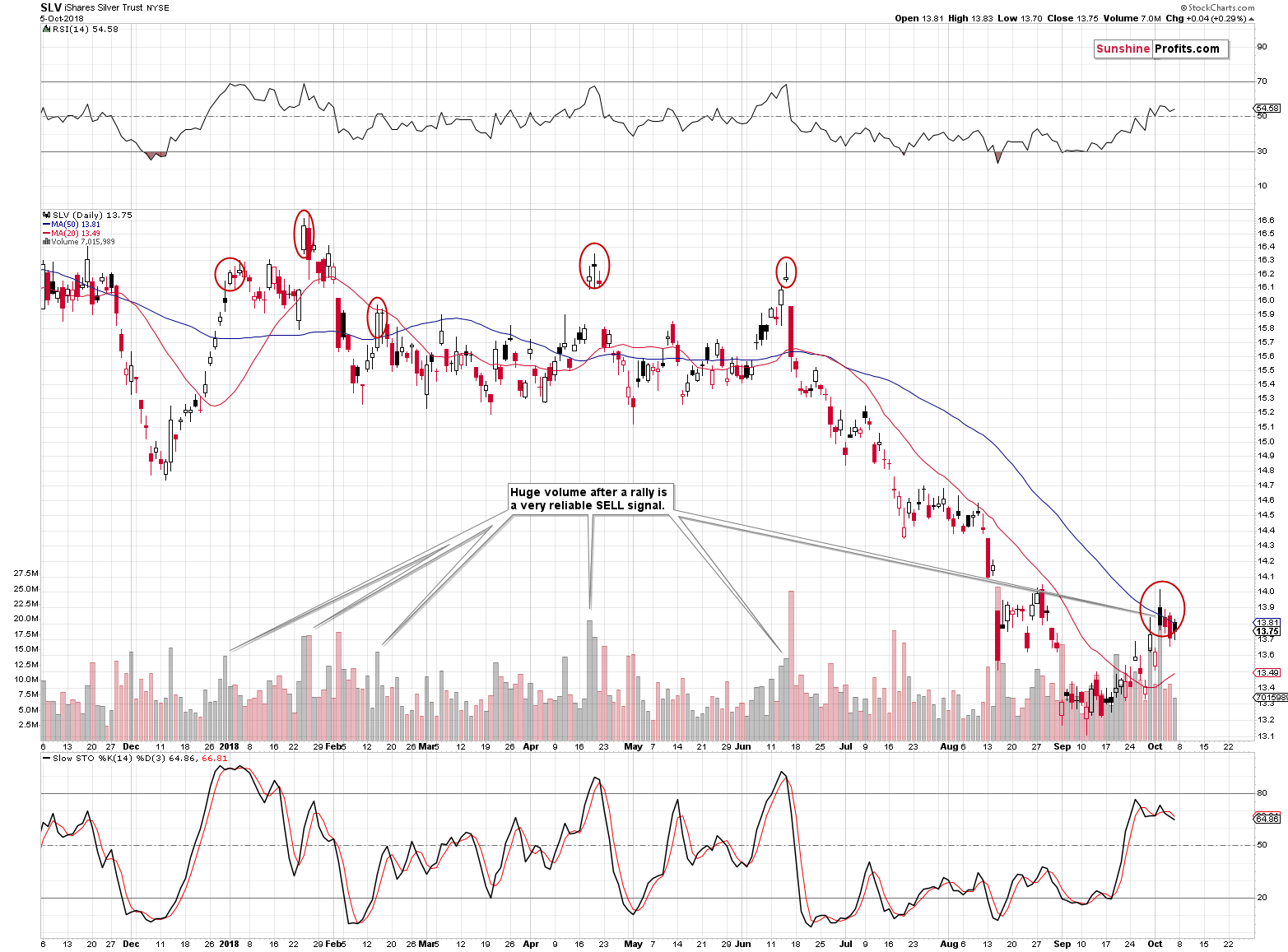
The situation now is very similar to what we saw at the previous tops, right before the significant declines.
And we have just seen an important short-term confirmation from the mining stocks.
Mining Stocks’ Short-term Signal
Gold and silver moved a bit lower yesterday. It’s not odd because the USD Index declined a bit on Friday. What is odd and significant, however, is the fact that despite this situation the gold stocks declined. They should have moved higher, but they didn’t which is a bearish sign.
The general stock market declined on Friday, but the move was not significant enough to really justify this extent of mining stocks’ weakness.
Preparing for the Stock Market Volatility
Speaking of the general stock market and its decline, the last two trading days were declines and while we are not yet seeing any dramatic decline, it may be a good time to prepare for such. And by preparing for it, we mean considering what might happen to the price of gold if we see a significant increase in the volatility of the main stock indices. If we see the latter, we’ll also – almost certainly – see articles and interviews where people will say that gold could rally because of this increase.
By preparing for it, we mean recalling that an increased volatility in the general stock market is not likely to trigger a rally in the precious metals. That’s just an easy thing to say when being asked during an interview. Gold is often treated as a safe haven, so when investors become nervous, they will turn to the yellow metal, seeing safety. Right? As long as you don’t check the facts, it seems perfectly understandable.
But we did check the facts when the above was a popular trigger that was supposed to launch gold above $1,500. On January 31st, 2018, right after the initial decline in the S&P 500, we wrote that the implications are not bullish and that gold can even decline along with the S&P.
Moreover, in April, we discussed the link between gold and the volatility index – VIX. We wrote the following:
Since 2011 things have changed as 75% of cases (6 out of 8) were good shorting opportunities. The remaining 2 cases were good opportunities to go long. So, on average, it seems that as far as the current stage of the gold market is concerned, spikes in the VIX should be viewed a sell signs for gold rather than buy signs.
Naturally, the above is not strong enough on its own to make the outlook bearish, but it’s a useful confirmation technique that can supplement other, more reliable, signals.
During the most recent spike in the VIX, gold was just after a short-term upswing and the rally stopped shortly. It seems like it is yet another time when the increased volatility in the stock market confirms that we currently have a great shorting opportunity.
What happened shortly thereafter?
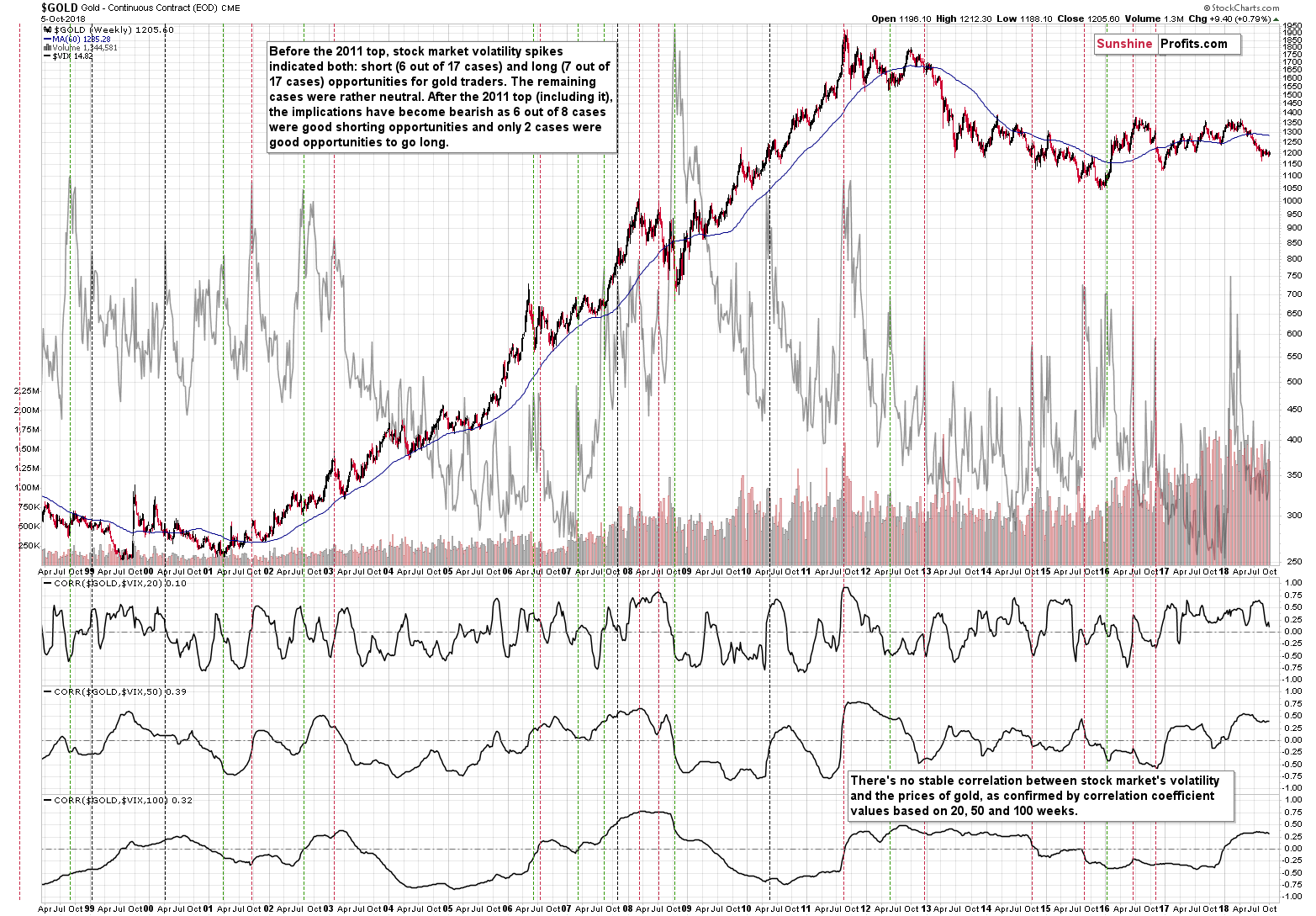
Gold declined, thus further increasing the bearish statistics. The current reading is that since 2011, 77.8% of cases (7 out of 9) when VIX spiked were good shorting opportunities.
The above doesn’t change anything at the moment, but please keep it in mind, if the S&P declines and you read that another decline and/or volatility is going to send gold to the moon. Quick fact-check suggests the opposite.
Now, since we are already discussing the long-term charts, let’s take a look at the current situation in the PMs from the long-term point of view.
Gold’s and Silver’s Long-term Signals and Targets
The key things that we see on the above gold chart are gold’s very long-term turning point, and the vertex of the triangle based on the previous major extremes (2012 and 2017 tops, and 2015 and 2016 bottoms). They both point to a major reversal that’s likely to take place right now or very close to the current moment. We recently saw a short-term top, so perhaps that was the final top before a very important price decline. That’s what appears likely, based on multiple signals that we have in place, including the remarkable similarity to 2013, so the thing that these two techniques imply is that “it’s time”.

As far as silver is concerned, we would like to point out the fact that despite the early gains, silver actually declined last week, only briefly touching the rising red resistance line, thus verifying the breakdown below it. The decline can now resume.
Finally, we would like to emphasize that the above 2 long-term charts provide our up-to-date targets in terms of both price and time – it seems that we’ll get a big decline right away (or very soon), then a rebound (perhaps for 2 weeks or so), and then another slide to the final lows that could take place in the next several weeks. Naturally, we’ll keep you updated when things move forward and we have more details, but the above is what appears most likely based on the data that we have right now.
Also, before summarizing, we would like to once again emphasize that despite the intraweek attempt, there was still no invalidation of the long-term breakdown in platinum.

The platinum price closed the week below the 2016 bottom and also below the weekly high that we saw 2 weeks earlier. The breakdown appears to be more than confirmed and the outlook is very bearish for the following weeks.
Important Analyses
Before summarizing, we would like to emphasize that we have recently posted several analyses that are very important and that one should keep in mind, especially in the next several weeks. If you haven’t had the chance of reading them previously, we encourage you to do so today:
- Dear Gold Investor - Letters from 2013 - Analogy to 2013, which should make it easier to trade the upcoming sizable upswing (if enough factors point to it, that is) and to enter the market close to the final bottom.
- Gold to Soar Above $6,000 - discussion of gold’s long-term upside target of $6,000.
- Preparing for THE Bottom in Gold: Part 6 – What to Buy - extremely important analysis of the portfolio structure for the next huge, multi-year rally in the precious metals.
- Preparing for THE Bottom in Gold: Part 7 – Buy-and-hold on Steroids - description of a strategy dedicated to significantly boosting one’s long-term investment returns while staying invested in the PM sector.
- Gold’s Downside Target, Upcoming Rebound, and Miners’ Buy Plan - details regarding the shape of the following price moves, a buying plan for mining stocks, and a brief discussion of the final price targets for the current decline.
- Gold: What Happened vs. What Changed - discussion of the latest extreme readings from gold’s CoT report
- Key Factors for Gold & Silver Investors - discussion of key, long-term factors that support the bearish outlook for PMs. We are often asked what makes us so bearish – this article is a reply to this question.
- The Upcoming Silver Surprise - two sets of price targets for gold, silver and mining stocks: the initial and the final one.
- Precious Metals Sector: It’s 2013 All Over Again - comparison between 2013 and 2018 throughout the precious metals sector, the general stock market and the USD Index. Multiple similarities point to the repeat of a 2013-style volatile decline in the PMs.
- Changing One's Mind - Why, When, and How – discussing the way of analyzing the market that helps to stay focused on the growing one’s capital while not being influenced by the loss aversion bias.
Summary
Summing up, the outlook for the precious metals sector remains extremely bearish even though not much seems to have happened in the final part of the previous week. It’s important to keep in mind the fact that it was precisely “nothing” that directly preceded the two-day $200+ decline in gold in April, 2013. Consequently, just because nothing changed in the last two trading days, it doesn’t mean that nothing is about to. All in all, it seems that the huge profits on our short positions will soon become enormous. And Friday’s underperformance of mining stocks seems to indicate that the waiting for decline’s continuation may be over.
As always, we’ll keep you – our subscribers – informed.
To summarize:
Trading capital (supplementary part of the portfolio; our opinion): Full short positions (250% of the full position) in gold, silver and mining stocks are justified from the risk/reward perspective with the following stop-loss orders and exit profit-take price levels:
- Gold: profit-take exit price: $1,062; stop-loss: $1,226; initial target price for the DGLD ETN: $82.96; stop-loss for the DGLD ETN $53.67
- Silver: profit-take exit price: $12.72; stop-loss: $15.16; initial target price for the DSLV ETN: $46.97; stop-loss for the DSLV ETN $31.37
- Mining stocks (price levels for the GDX ETF): profit-take exit price: $13.12; stop-loss: $19.61; initial target price for the DUST ETF: $80.97; stop-loss for the DUST ETF $33.37
Note: the above is a specific preparation for a possible sudden price drop, it does not reflect the most likely outcome. You will find a more detailed explanation in our August 1 Alert. In case one wants to bet on junior mining stocks’ prices (we do not suggest doing so – we think senior mining stocks are more predictable in the case of short-term trades – if one wants to do it anyway, we provide the details), here are the stop-loss details and target prices:
- GDXJ ETF: profit-take exit price: $17.52; stop-loss: $29.43
- JDST ETF: initial target price: $154.97 stop-loss: $64.88
Long-term capital (core part of the portfolio; our opinion): No positions (in other words: cash)
Insurance capital (core part of the portfolio; our opinion): Full position
Important Details for New Subscribers
Whether you already subscribed or not, we encourage you to find out how to make the most of our alerts and read our replies to the most common alert-and-gold-trading-related-questions.
Please note that the in the trading section we describe the situation for the day that the alert is posted. In other words, it we are writing about a speculative position, it means that it is up-to-date on the day it was posted. We are also featuring the initial target prices, so that you can decide whether keeping a position on a given day is something that is in tune with your approach (some moves are too small for medium-term traders and some might appear too big for day-traders).
Plus, you might want to read why our stop-loss orders are usually relatively far from the current price.
Please note that a full position doesn’t mean using all of the capital for a given trade. You will find details on our thoughts on gold portfolio structuring in the Key Insights section on our website.
As a reminder – “initial target price” means exactly that – an “initial” one, it’s not a price level at which we suggest closing positions. If this becomes the case (like it did in the previous trade) we will refer to these levels as levels of exit orders (exactly as we’ve done previously). Stop-loss levels, however, are naturally not “initial”, but something that, in our opinion, might be entered as an order.
Since it is impossible to synchronize target prices and stop-loss levels for all the ETFs and ETNs with the main markets that we provide these levels for (gold, silver and mining stocks – the GDX ETF), the stop-loss levels and target prices for other ETNs and ETF (among other: UGLD, DGLD, USLV, DSLV, NUGT, DUST, JNUG, JDST) are provided as supplementary, and not as “final”. This means that if a stop-loss or a target level is reached for any of the “additional instruments” (DGLD for instance), but not for the “main instrument” (gold in this case), we will view positions in both gold and DGLD as still open and the stop-loss for DGLD would have to be moved lower. On the other hand, if gold moves to a stop-loss level but DGLD doesn’t, then we will view both positions (in gold and DGLD) as closed. In other words, since it’s not possible to be 100% certain that each related instrument moves to a given level when the underlying instrument does, we can’t provide levels that would be binding. The levels that we do provide are our best estimate of the levels that will correspond to the levels in the underlying assets, but it will be the underlying assets that one will need to focus on regarding the signs pointing to closing a given position or keeping it open. We might adjust the levels in the “additional instruments” without adjusting the levels in the “main instruments”, which will simply mean that we have improved our estimation of these levels, not that we changed our outlook on the markets. We are already working on a tool that would update these levels on a daily basis for the most popular ETFs, ETNs and individual mining stocks.
Our preferred ways to invest in and to trade gold along with the reasoning can be found in the how to buy gold section. Additionally, our preferred ETFs and ETNs can be found in our Gold & Silver ETF Ranking.
As a reminder, Gold & Silver Trading Alerts are posted before or on each trading day (we usually post them before the opening bell, but we don't promise doing that each day). If there's anything urgent, we will send you an additional small alert before posting the main one.
=====
Latest Free Trading Alerts:
Stocks continued their short-term downtrend on Friday following the monthly jobs data release. The S&P 500 index fell to its late January local high of around 2,873, before a quick intraday upward reversal. So will downtrend continue? Or is this just some profit-taking action before another medium-term leg up?
New Downtrend or Just Downward Correction?
=====
Thank you.
Sincerely,
Przemyslaw Radomski, CFA
Founder, Editor-in-chief, Gold & Silver Fund Manager
Gold & Silver Trading Alerts
Forex Trading Alerts
Oil Investment Updates
Oil Trading Alerts


